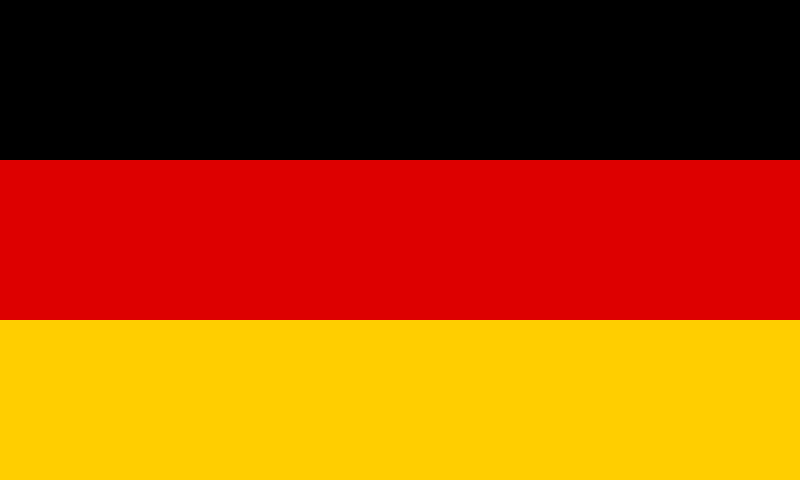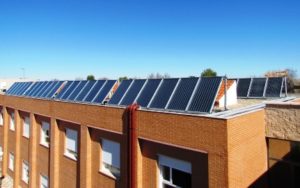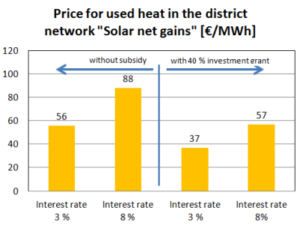Solar thermal is economically viable in Germany in multi-family buildings – that is the clear message of the Excel-based tool which German solar thermal system supplier Remeha, a brand of the BDR Thermea Group, uses to calculate solar water heater performance at multi-family dwellings. The Excel tool was created for installers and planners to support their offers of solar hot water or space heating for blocks of flats. The tool calculates a kWh price, as well as the investment’s Internal Rate of Return. The solar heat produces the most cost-effective kWh with 43.3 EUR/MWh, assuming a 20-year lifetime. During this period, earnings are double as high as investment costs.
“At the moment, we are experiencing growing demand from builders in Germany because of the Renewable Energy Heat Act and the high level of funding,” confirms Erich Terbrack, Product Manager at Remeha. “One fourth of our collectors sold in Germany are being installed at multi-family buildings in the meantime.” There is, however, a need for an intensive follow-up regarding the builders, architects and planners. “They need to be comfortable with solar and convinced of the reliable technology with little after-sales service, otherwise they do not go with a boiler + solar solution,” Terbrack points out. The economic calculator is one of the measures to increase planners’ confidence in solar solutions. The requirements and results of a typical solar installation with 27 m² of collector area and a price of EUR 19,000, including installation and VAT, for a multi-family building with eleven units are shown in table 1.
|
Block of flats
|
Eleven units with about 920 m² of floor space
|
|
Solar thermal combi system
|
Eleven collectors, 27 m² of collector area and 1,300 to 1,500 litres of tank storage
|
|
Total investment costs
|
Around 19,000 EUR, including installation and VAT
|
|
Specific solar yield
|
350 kWh/m²
|
Table 1: Description of client building and related solar installation; the size is a Remeha recommendation for fulfilling the German Energy Saving Ordinance, EnEV 2014, with a collector system taking up 0.03 % of floor space and having a tank volume of 40 litres per m² of collector area. The solar yield is a fixed sum in the calculation for combi systems and is based on system tests by Remeha over the last 10 years.
Source: Remeha
Together with the Excel tool, Remeha offers a list of the most important calculation factors:
- The number of dish washers or washing machines that will be linked to the hot water circuit. Each machine with a hot water connection saves up to about EUR 50 on an annual electricity bill in Germany. Dish washers can be connected to the hot water circuit without additional cost, washing machines need a special device for it. The present case study considers one machine per housing unit to be fed with solar-heated water.
- The German Market Rebate Programme for Renewable Energies, MAP, grants 140 EUR/m² of collector area for combi systems in multi-family buildings. The related subsidy of EUR 3,780 for the 27 m² field will be subtracted from the investment costs.
- The calculator only considers investment costs related to the solar system. It will reduce the costs by components necessary for hot water preparation even without solar collectors, such as the hot water storage tank volume of 500 litres you would even need without solar, the installation of the warm water and circulation circuit, the heating circuit between boiler and hot water tank and the pump. In the case study above, these factors add up to EUR 3,350 and they will be subtracted from the investment costs.
- The growth rate of fossil fuel prices is set at 3 % in this example. Remeha emphasises in its listing that energy prices have increased on average by 6 % per year over the last 35 years.
- The economic calculation does not include financing costs, because they vary a lot from builder to builder.
Solar heat produces the most cost-effective kWh with 43.3 EUR/MWh, assuming a 20-year lifetime of the system. Heat from gas boilers is at around 60 EUR/MWh and heat from oil boilers at around 80 EUR/MWh.
“Builders are used to comparing their investments related to the Internal Rate of Return,” states Terbrack. Hence, the calculation tool also calculates the IRR. When the above-mentioned case study considers the recommended calculation measures found in Remeha’s listing, it shows a rather high IRR of 16.6 %. Table 2 shows the impact of the different recommended calculation factors on the IRR and the solar heat costs. Without incentives, warm-water-connected dish washers and conventional heating components, the IRR decreases to 6.2 % and the solar kWh costs rise to 69.7 EUR/MWh.
|
Recommended calculation models
|
Resulting Internal Rate of Return
|
Resulting solar heat costs
|
Savings over 20-year lifetime
|
|
Considering all three calculation factors: 11 warm-water-connected dish washers, incentives, without conventional heating components
|
16.6 %
|
43.3 EUR/MWh
|
EUR 39,253
|
|
With incentives but without conventional heating components
|
10.4 %
|
43.3 EUR/MWh
|
EUR 24,475
|
|
Without conventional heating components
|
8 %
|
55.5 EUR/MWh
|
EUR 24,090
|
|
None
|
6.2 %
|
69.7 EUR/MWh
|
EUR 23,755
|
Table 2: Economic calculation based on different factors
Source: Remeha Cost Calculator



